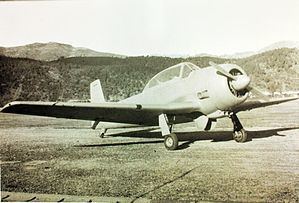Top speed 350 km/h Length 9.25 m | Wingspan 13 m Manufacturer Piaggio Aerospace | |
 | ||
The Piaggio P.150 was a 1950s Italian two-seat trainer designed and built by Piaggio to meet an Italian Air Force requirement to replace the North American T-6.
Contents
Development
The P.150 was designed and built to compete as an Italian Air Force T-6 replacement against the Fiat G.49 and Macchi MB.323. The P.150 was an all-metal low-wing cantilever monoplane with a wide-track retractable tailwheel landing gear. The pilot and instructor were seated in tandem under one glazed canopy. It was originally powered by a Pratt & Whitney Wasp radial engine and later an Alvis Leonides engine. The aircraft was not chosen and did not go into production.
Operators
Specifications (P.150)
Data from Jane's All The World's Aircraft 1953-54
General characteristics
Performance
References
Piaggio P.150 Wikipedia(Text) CC BY-SA
